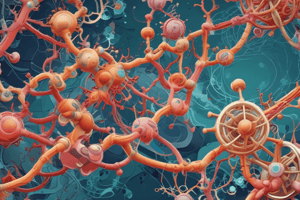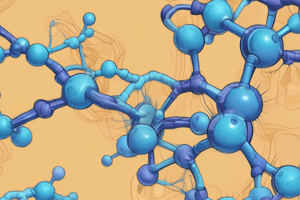Podcast
Questions and Answers
What is the first level of higher-order structure in proteins?
What is the first level of higher-order structure in proteins?
- Primary structure (correct)
- Quaternary structure
- Tertiary structure
- Secondary structure
What type of bonds are responsible for forming secondary protein structures such as alpha helices and beta sheets?
What type of bonds are responsible for forming secondary protein structures such as alpha helices and beta sheets?
- Ionic bonds
- Hydrogen bonds (correct)
- Disulfide bridges
- Peptide bonds
Which protein structure involves the overall 3D arrangement of a polypeptide chain?
Which protein structure involves the overall 3D arrangement of a polypeptide chain?
- Tertiary structure (correct)
- Secondary structure
- Quaternary structure
- Primary structure
What determines a protein's specific structure?
What determines a protein's specific structure?
What does the quaternary structure of a protein involve?
What does the quaternary structure of a protein involve?
Which amino acid characteristic primarily defines the chemistry of proteins?
Which amino acid characteristic primarily defines the chemistry of proteins?
What is the main feature of tertiary protein structure?
What is the main feature of tertiary protein structure?
What can small differences in bonds between glucose molecules lead to?
What can small differences in bonds between glucose molecules lead to?
What is the primary role of water in biological systems?
What is the primary role of water in biological systems?
Which of the following correctly identifies a type of macromolecule that is not a polymer?
Which of the following correctly identifies a type of macromolecule that is not a polymer?
What is the process called when water is removed to form a polymer?
What is the process called when water is removed to form a polymer?
Which enzyme specifically catalyzes the polymerization of nucleic acids?
Which enzyme specifically catalyzes the polymerization of nucleic acids?
Which statement is true regarding hydrolases?
Which statement is true regarding hydrolases?
When discussing monomers, which of the following statements is accurate?
When discussing monomers, which of the following statements is accurate?
Which type of molecule is made up of polymers of amino acids?
Which type of molecule is made up of polymers of amino acids?
What happens to water during depolymerization reactions?
What happens to water during depolymerization reactions?
What does resolution in microscopy refer to?
What does resolution in microscopy refer to?
Which type of microscopy uses reflected light?
Which type of microscopy uses reflected light?
Which statement about magnification and resolution is correct?
Which statement about magnification and resolution is correct?
Which microscopy technique allows observation of smaller specimens clearly due to higher contrast?
Which microscopy technique allows observation of smaller specimens clearly due to higher contrast?
What is one of the primary purposes of using differential interference contrast (DIC) microscopy?
What is one of the primary purposes of using differential interference contrast (DIC) microscopy?
What does the cell theory state regarding the origin of cells?
What does the cell theory state regarding the origin of cells?
Why do larger cells face challenges related to their size?
Why do larger cells face challenges related to their size?
Which of the following statements is true about cellular organisms?
Which of the following statements is true about cellular organisms?
What was one of the first observations of cells using a microscope in the 1600s?
What was one of the first observations of cells using a microscope in the 1600s?
What structural adaptation might a cell develop if it requires a larger surface area?
What structural adaptation might a cell develop if it requires a larger surface area?
In the context of cellular size, what does the trade-off refer to?
In the context of cellular size, what does the trade-off refer to?
Which types of cells are typically larger than typical mammalian somatic cells?
Which types of cells are typically larger than typical mammalian somatic cells?
What role does microscopy play in biology?
What role does microscopy play in biology?
Flashcards
Water's role in life
Water's role in life
Water is the primary solvent in living organisms. It dissolves more substances than any other solvent due to its polar nature.
What are macromolecules?
What are macromolecules?
Macromolecules are large, complex molecules essential for life. They are composed of smaller building blocks known as monomers.
What are carbohydrates?
What are carbohydrates?
Carbohydrates are polymers made up of sugar monomers. They serve as energy sources and structural components in cells.
What are lipids?
What are lipids?
Signup and view all the flashcards
What are proteins?
What are proteins?
Signup and view all the flashcards
What are nucleic acids?
What are nucleic acids?
Signup and view all the flashcards
What is polymerization?
What is polymerization?
Signup and view all the flashcards
What is depolymerization?
What is depolymerization?
Signup and view all the flashcards
Primary protein structure
Primary protein structure
Signup and view all the flashcards
Secondary protein structure
Secondary protein structure
Signup and view all the flashcards
Tertiary protein structure
Tertiary protein structure
Signup and view all the flashcards
Quaternary protein structure
Quaternary protein structure
Signup and view all the flashcards
What determines a protein's structure?
What determines a protein's structure?
Signup and view all the flashcards
Amino acid side chains
Amino acid side chains
Signup and view all the flashcards
Peptide bonds
Peptide bonds
Signup and view all the flashcards
Glucose chain structures
Glucose chain structures
Signup and view all the flashcards
Resolution
Resolution
Signup and view all the flashcards
Magnification and resolution
Magnification and resolution
Signup and view all the flashcards
Contrast
Contrast
Signup and view all the flashcards
Reflected light microscopy
Reflected light microscopy
Signup and view all the flashcards
Transmitted light microscopy
Transmitted light microscopy
Signup and view all the flashcards
Cell Theory
Cell Theory
Signup and view all the flashcards
Cell Size
Cell Size
Signup and view all the flashcards
Surface Area to Volume Ratio
Surface Area to Volume Ratio
Signup and view all the flashcards
Surface Area Adaptations
Surface Area Adaptations
Signup and view all the flashcards
Large Volume Adaptation
Large Volume Adaptation
Signup and view all the flashcards
Microscopes and Cell Discovery
Microscopes and Cell Discovery
Signup and view all the flashcards
Early Microscope Observations
Early Microscope Observations
Signup and view all the flashcards
Types of Microscopes
Types of Microscopes
Signup and view all the flashcards
Study Notes
Molecules of Life
- Water is the solvent of life
- Water dissolves more molecules than any other solvent
- Water is a polar molecule (opposite charges on either end)
- Water dissolves other polar molecules
- Water dissolves charged molecules
Macromolecules
- Carbohydrates are polymers of sugars
- Lipids are not polymers
- Proteins are polymers of amino acids
- Nucleic acids are polymers of nucleotides
Polymers
- Chains composed of molecules called monomers
- Polymerize and depolymerize
- Polymerization/depolymerization reactions involve addition or loss of water.
- Dehydration synthesis (polymerization)
- Hydrolysis (depolymerization)
- Addition or loss of water happens at the bonds between monomers
- Enzymes catalyze the synthesis/hydrolysis of polymers
- Polymerases
- Hydrolases
- Nice trick: -ase = enzyme
Enzyme example: DNA Polymerization
- DNA Polymerase catalyzes the polymerization of DNA (a nucleic acid)
Biopolymers
- Most biopolymers are not just simple chains of monomers
- The chains usually twist and fold forming varied levels of higher-order structure
- Examples: DNA double helix, Protein folding
Higher-order Polymer Structure Example: Proteins
- 1° structure: amino acid chain
- 2° structure: ex) a-helix, β-sheet
- 3° structure: folding
- 4° structure: assembling with other proteins into a complex
Amino Acids
- Contain Nitrogen, mildly acidic
- R = sidechain
- Sidechain properties define the chemistry of proteins
Primary Protein Structure
- Amino acids are linked by covalent bonds called peptide bonds
- Proteins also known as polypeptides
Amino Acid Structure and Properties
- Earthlings use 20 different AA's
Secondary Protein Structure
- Hydrogen bonds between nearby amino acids cause the polypeptide to twist (alpha helix) or form sheets (beta sheets)
Tertiary Protein Structure
- Chemistry between sidechains causes higher-order folding
Quaternary Protein Structure
- Individual proteins interact to form complexes
- Again, determined by their structure and chemistry
Fun Fact: Chains of Glucose
- Small differences in glucose bonds create huge differences in the properties of these carbohydrates and their structure
- Cellulose, Starch, Glycogen
- All are chains of glucose
- Different bonds result in varying structures and shapes
Cell Theory
- All organisms are composed of one or more cells.
- The cell is the basic structural and functional unit of all living organisms.
- Cells arise only from the division of pre-existing cells.
First Observations of Cells using Microscopes
- Robert Hooke looked at cork cells
- Anton van Leeuwenhoek made a better microscope, and saw "many very little animacules, very prettily a-moving"
Cellular Scales
- Cells are generally pretty small
- Examples of cellular sizes are given for reference
Cell Size Scales and Visibility
- Unaided human eye
- Light microscope
- Electron microscope
Why Cells Tend to Be Small
- Surface area must be sufficient to allow exchange of stuff between the cell and its surroundings
- Larger volumes require more surface area to achieve this
- Larger volumes need more structural support
Trade-off Between Cell Surface Area and Volume
- The problem is that as volume increases, the surface area does not increase proportionately.
But what if the cell really requires a large surface area?
- Develop convoluted / branchy surface morphologies
What if the cell needs a large volume?
- Using cell walls (e.g., xylem vessels from wood)
Microscopy
- Resolution, magnification, and contrast
- Resolution- The ability of a microscope to distinguish two objects as being separate
- Higher magnification increases resolution
- Higher contrast gives more detail, but can't increase resolution
- Microscopy types: Light Microscopy (reflected light, transmitted light, and fluorescence), Electron Microscopy (transmission, and scanning)
Microscopy Types
- Brightfield, Darkfield, Phase-Contrast, Differential Interference Contrast (DIC)
- Contrast-enhancing methods
- Exploiting properties of the specimens
- Variations in specimen thickness and density
- Methods influence how light passes through
Studying That Suits You
Use AI to generate personalized quizzes and flashcards to suit your learning preferences.




